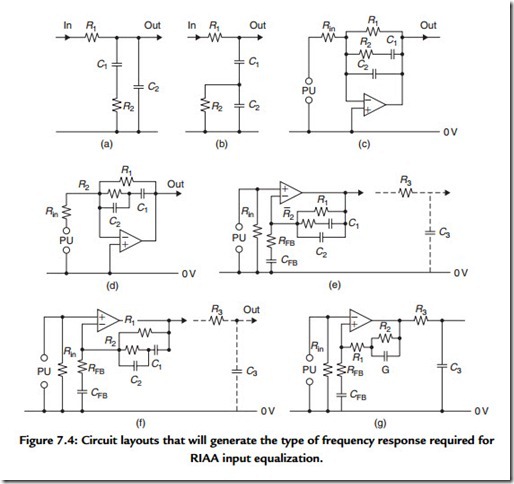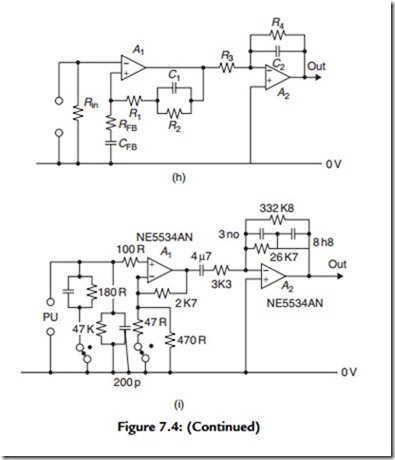Input Circuitry
Most of the inputs to the preamplifier will merely require appropriate amplification and impedance transformation to match the signal and impedance levels of the source to those required at the input of the power amplifier. However, the necessary equalization of the input frequency response from a moving magnet, moving coil, or variable reluctance PU cartridge, when replaying an RIAA preemphasized vinyl disc, requires special frequency shaping networks.
Various circuit layouts have been employed in the preamplifier to generate the required RIAA replay curve for velocity sensitive PU transducers, and these are shown in Figure 7.4. Of these circuits, the two simplest are the “passive” equalization networks shown in Figures 7.4(a) and 7.4(b), although for accuracy in frequency response they require that the source impedance is very low and that the load impedance is very high in relation to R1.
The required component values for these networks have been derived by Livy2 in terms of RC time constants and set out in a more easily applicable form by Baxandall3 in his analysis of the various possible equalization circuit arrangements.
From the equations quoted, the component values required for use in the circuits of Figures 7.4(a) and 7.4(c) would be
The circuit arrangements shown in Figures 7.4(c) and 7.4(d) use “shunt” type negative feedback (i.e., that type in which the negative feedback signal is applied to the amplifier in parallel with the input signal) connected around an internal gain block.
These layouts do not suffer from the same limitations with respect to source or load as the simple passive equalization systems of Figures 7.4(a) and 7.4(b). However, they do have the practical snag that the value of Rin will be determined by the required PU input load resistor (usually 47k for a typical moving magnet or variable reluctance type of PU
cartridge), and this sets an input “resistor noise” threshold, which is higher than desirable, as well as requiting inconveniently high values for R1 and R2.
For these reasons, the circuit arrangements shown in Figures 7.4(e) and 7.4(f) are found much more commonly in commercial audio circuitry. In these layouts, the frequency response shaping components are contained within a “series” type feedback network (i.e., one in which the negative feedback signal is connected to the amplifier in series with the input signal), which means that the input circuit impedance seen by the amplifier is essentially that of the PU coil alone and allows a lower midrange “thermal noise” background level.
The snag, in this case, is that at very high frequencies, where the impedance of the frequency-shaping feedback network is small in relation to RFB, the circuit gain approaches unity, whereas both the RIAA specification and the accurate reproduction of transient waveforms require that the gain should asymptote to zero at higher audio frequencies.
This error in the shape of the upper half of the response curve can be remedied by the addition of a further CR network, C3/R3, on the output of the equalization circuit, as shown in Figures 7.4(e) and 7.4(f). This amendment is sometimes found in the circuit designs used by the more perfectionist of the audio amplifier manufacturers.
Other approaches to the problem of combining low input noise levels with accurate replay equalization are to divide the equalization circuit into two parts, in which the first part, which can be based on a low noise series feedback layout, is only required to shape the 20-Hz to 1-kHz section of the response curve. This can then be followed by either a simple passive RC roll-off network, as shown in Figure 7.4(g), or by some other circuit arrangement having a similar effect, such as that based on the use of a shunt feedback connected around an inverting amplifier stage, as shown in Figure 7.4(h), to generate that part of the response curve lying between 1 kHz and 20 kHz.
A further arrangement, which has attracted the interest of some Japanese circuit designers—as used, for example, in the Rotel RC-870BX preamp, of which the RIAA equalizing circuit is shown in a simplified form in Figure 7.4—simply employs one of the recently developed very low noise IC op-amps as a flat frequency response input buffer stage. This is used to amplify the input signal to a level at which circuit noise introduced by succeeding stages will only be a minor problem and also to convert the PU input impedance level to a value at which a straightforward shunt feedback equalizing circuit can be used, with resistor values chosen to minimize any thermal noise background rather than being dictated by the PU load requirements.
The use of “application-specific” audio ICs, to reduce the cost and component count of RIAA stages and other circuit functions, has become much less popular among the designers of higher quality audio equipment because of the tendency of the semiconductor manufacturers to discontinue the supply of such specialized ICs when the economic basis of their sales becomes unsatisfactory or to replace these devices by other, notionally equivalent, ICs that are not necessarily either pin or circuit function compatible.
There is now, however, a degree of unanimity among the suppliers of ICs as to the pin layout and operating conditions of the single and dual op-amp designs, commonly packaged in eight-pin dual-in-line forms. These are typified by the Texas Instruments TL071 and TL072 ICs or their more recent equivalents, such as the TL051 and TL052 devices; there is a growing tendency for circuit designers to base their circuits on the use of ICs of this type, and it is assumed that devices of this kind would be used in the circuits shown in Figure 7.4.
An incidental advantage of the choice of this style of IC is that commercial rivalry between semiconductor manufacturers leads to continuous improvements in the specification of these devices. Since these nearly always offer plug-in physical and electrical interchangeability, the performance of existing equipment can be upgraded easily, either on the production line or by the service department, by the replacement of existing op-amp ICs with those of a more recent vintage, which is an advantage to both manufacturer and user.


